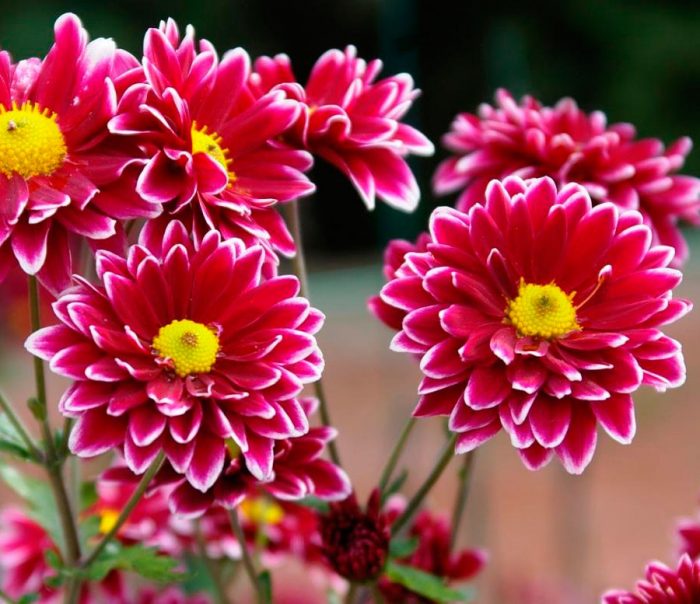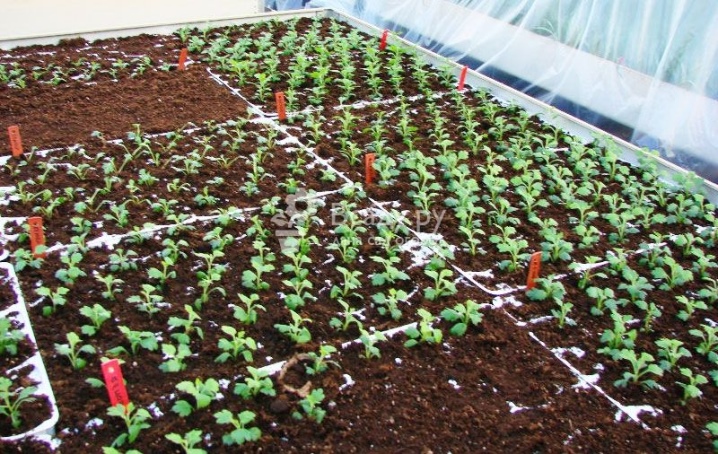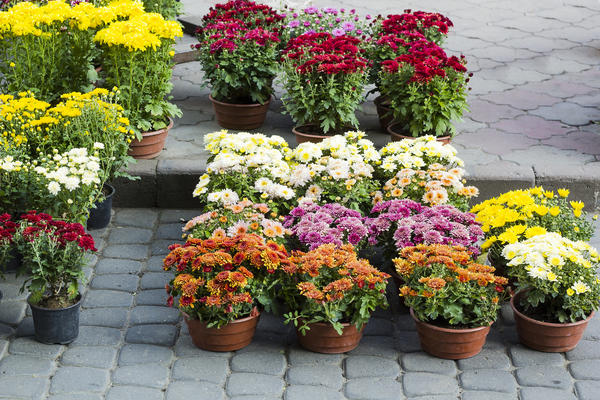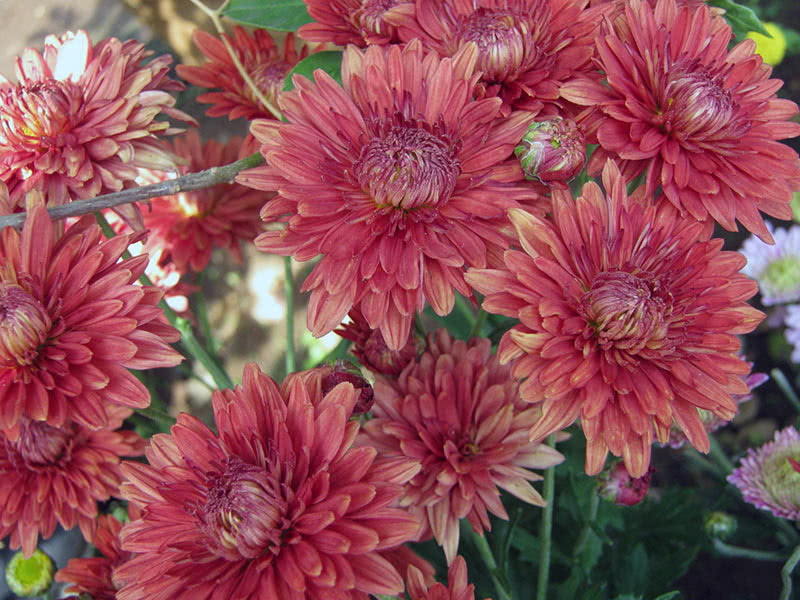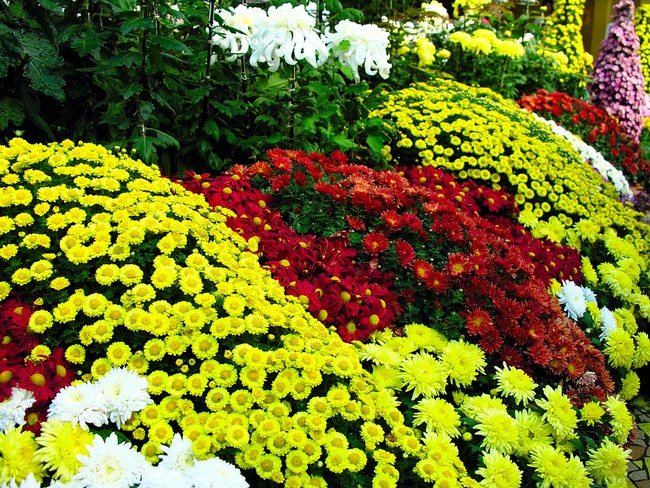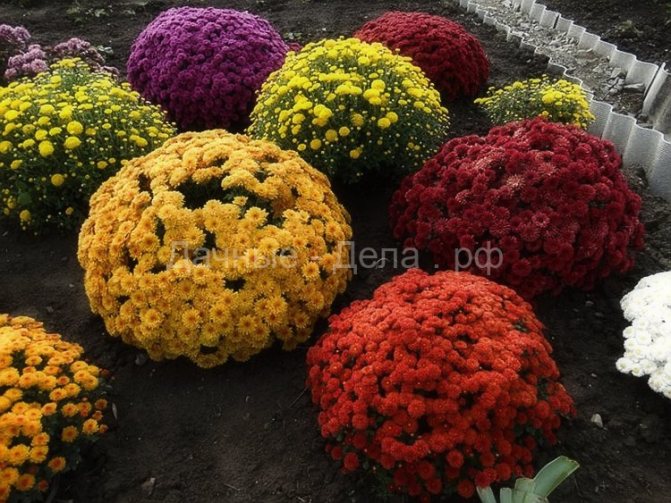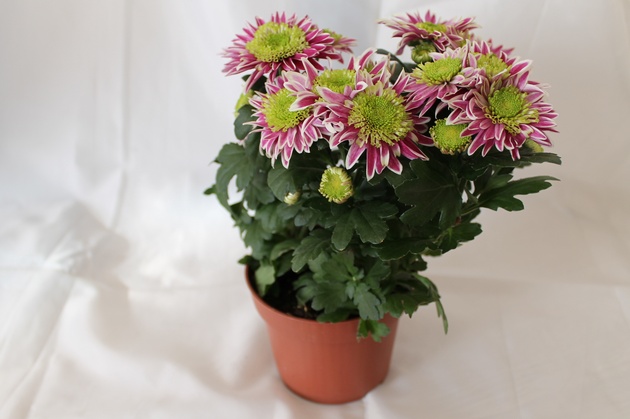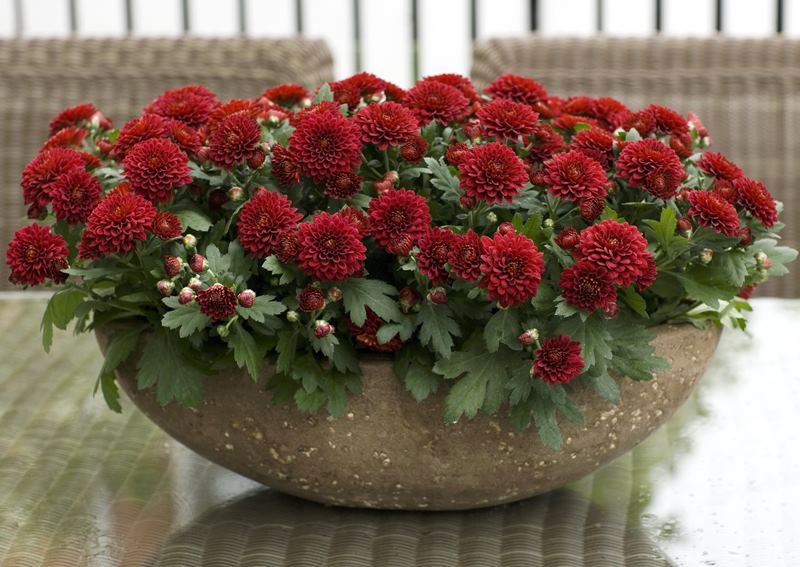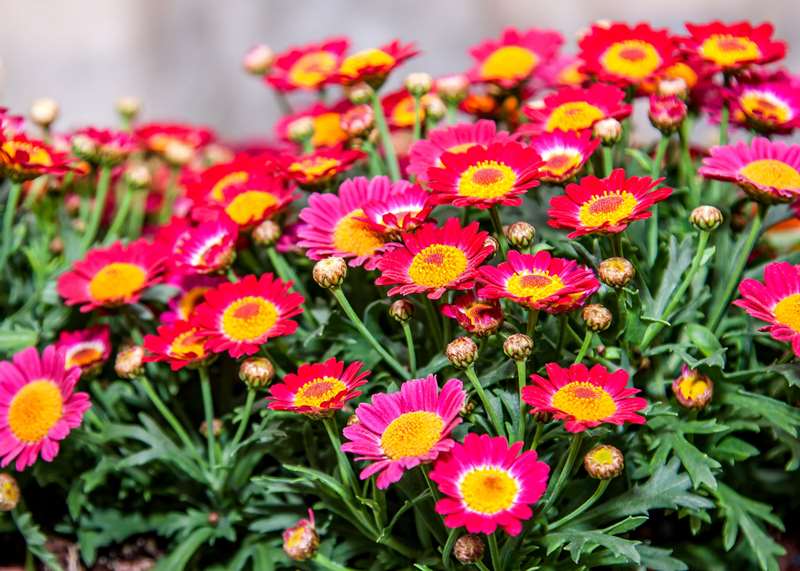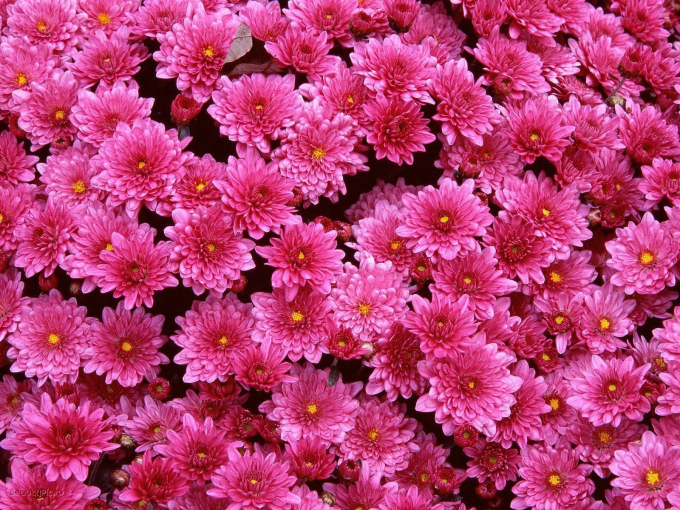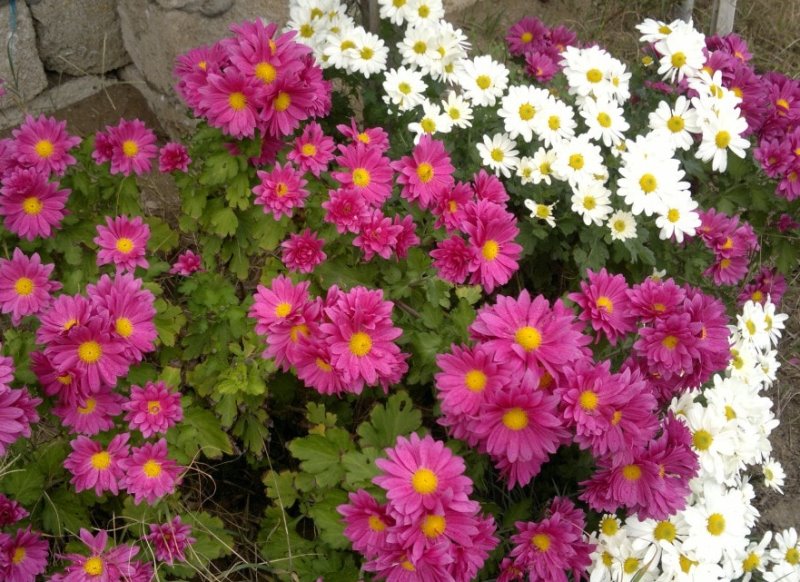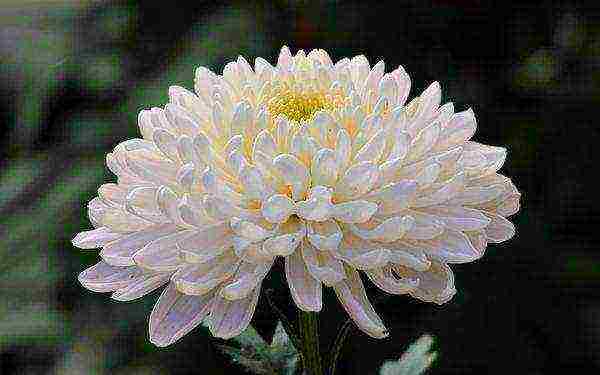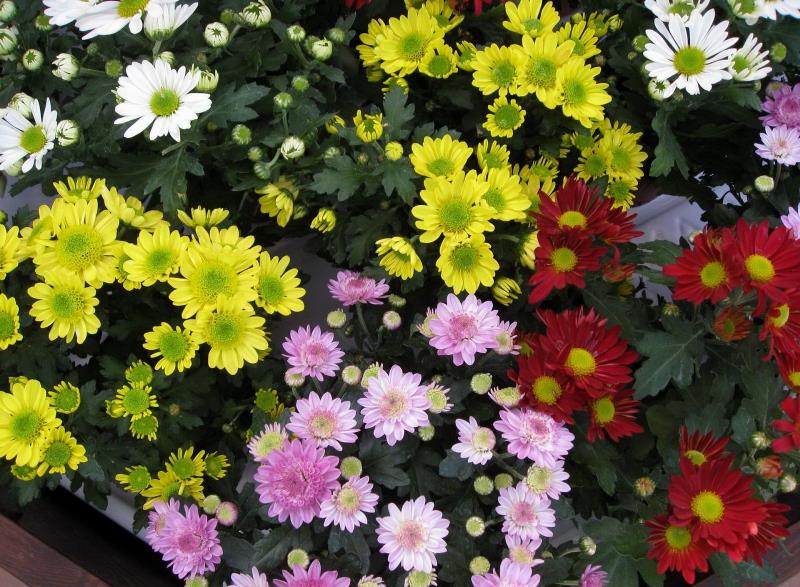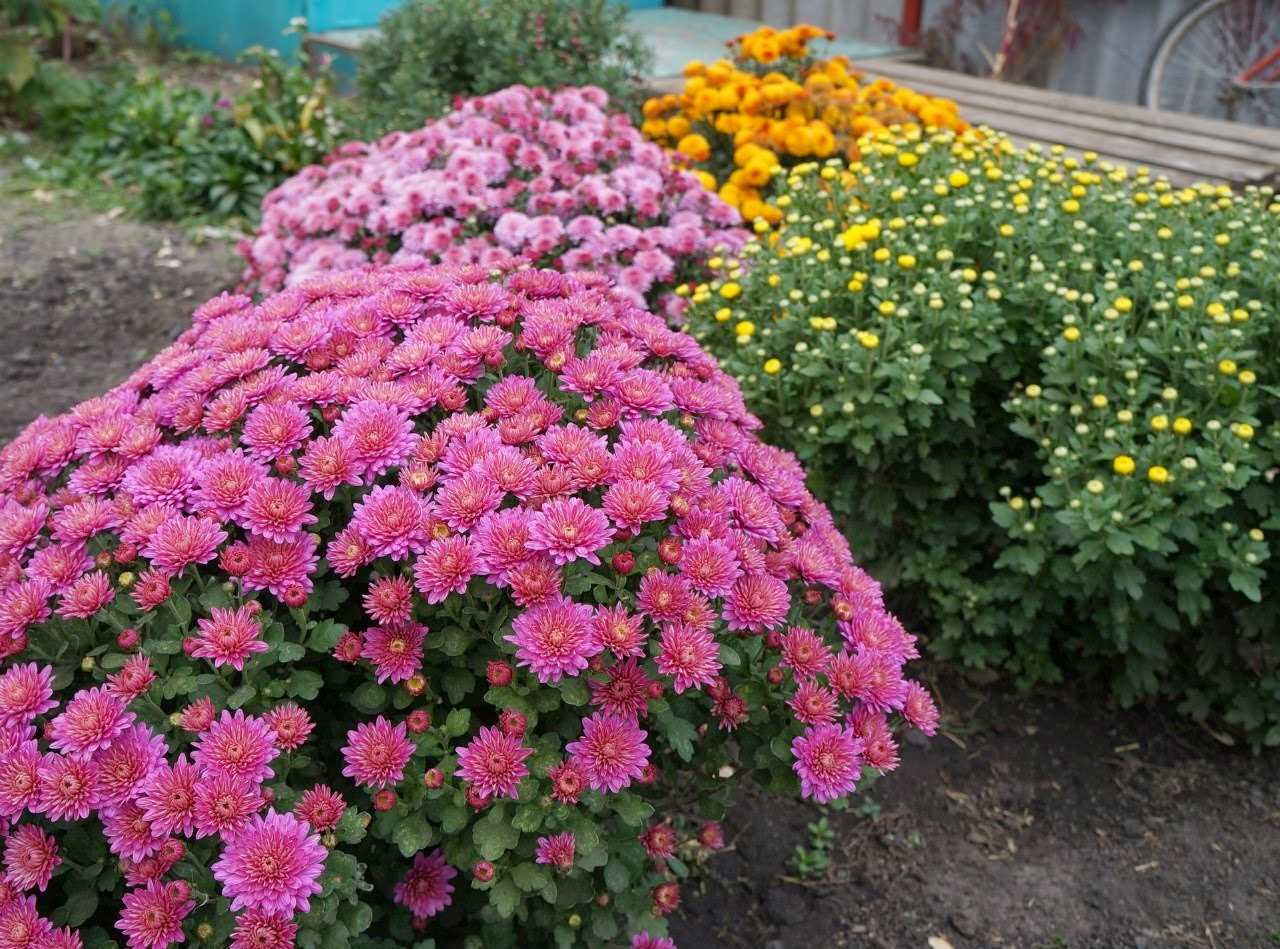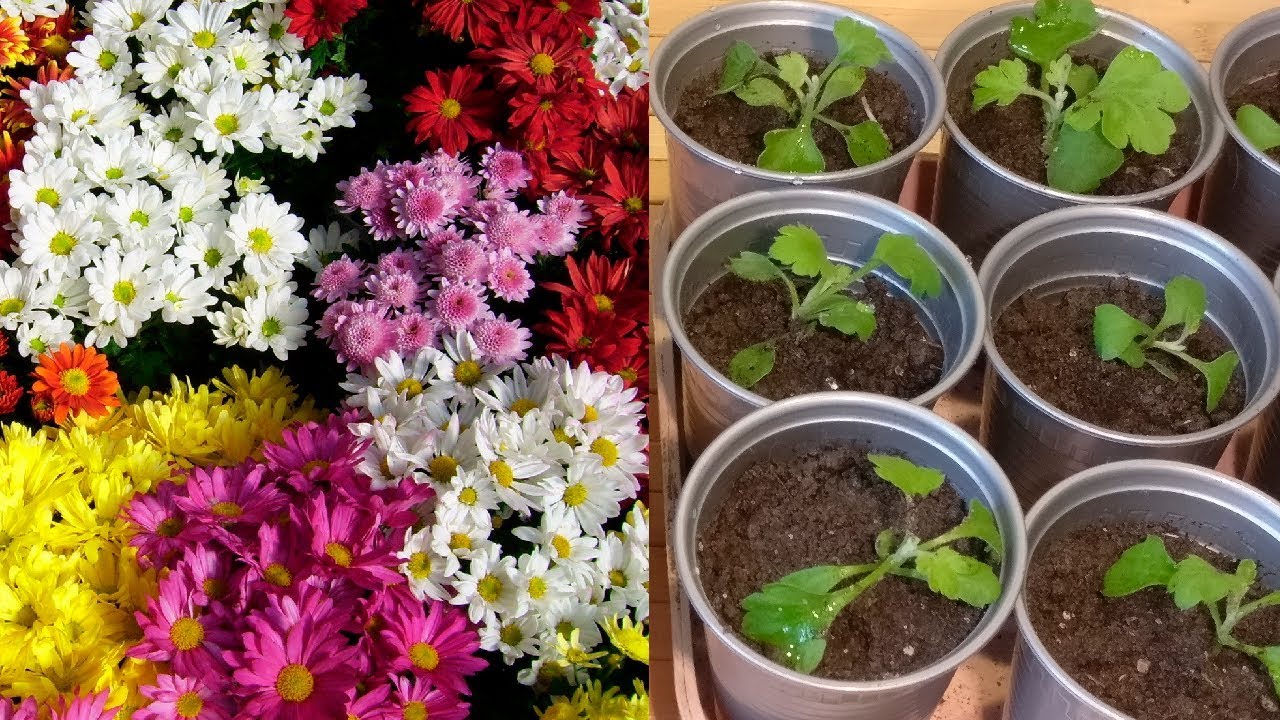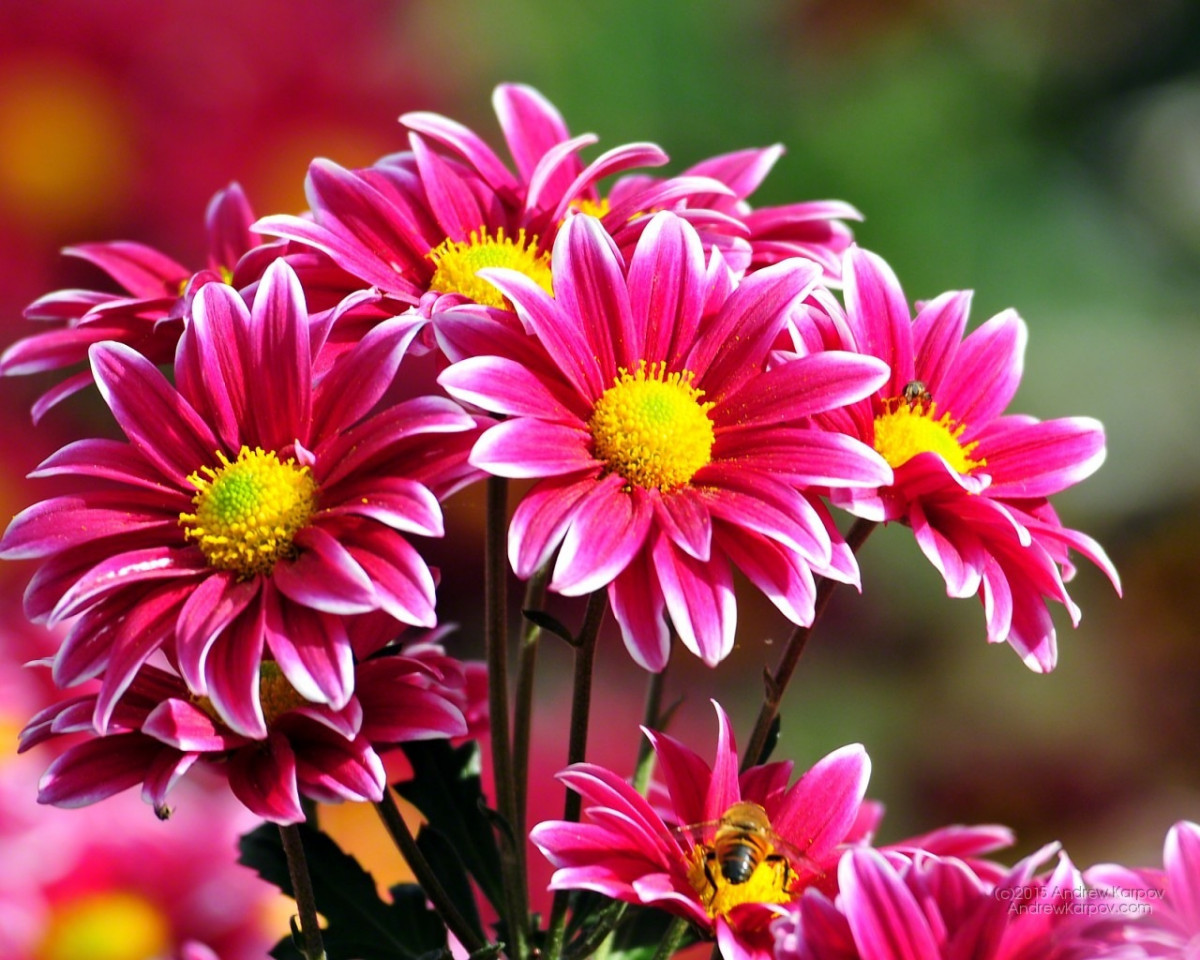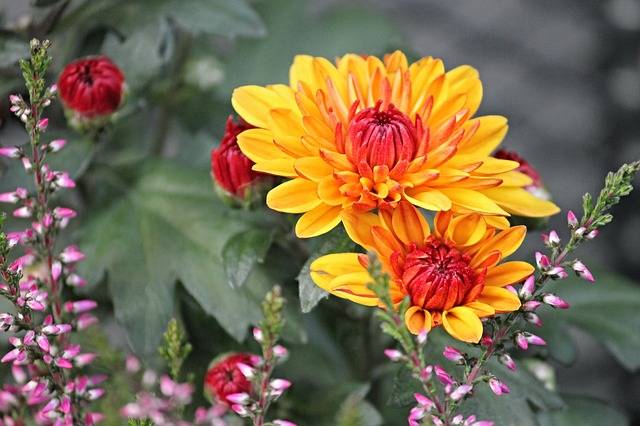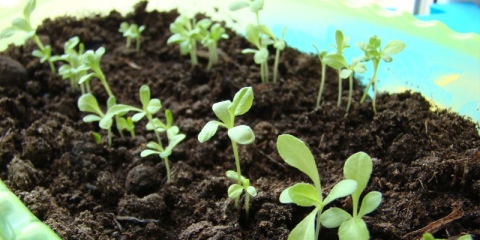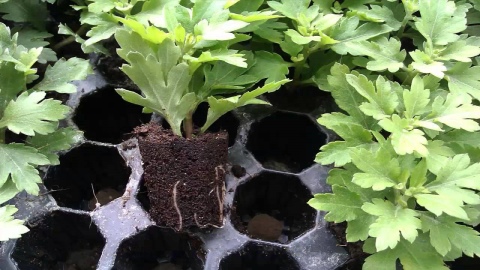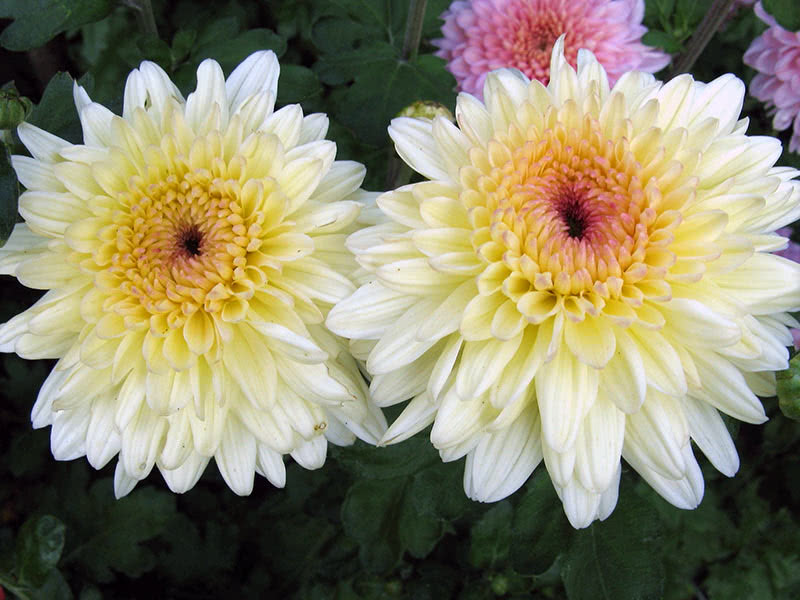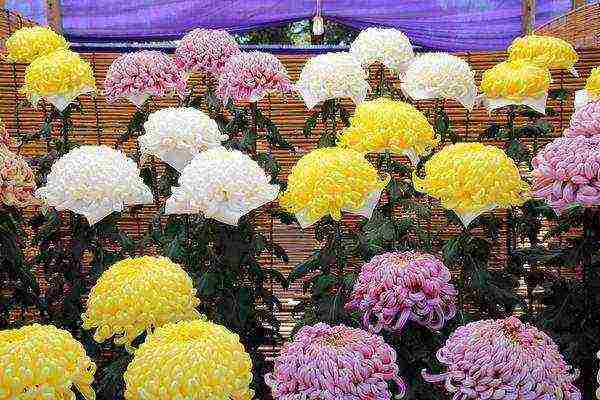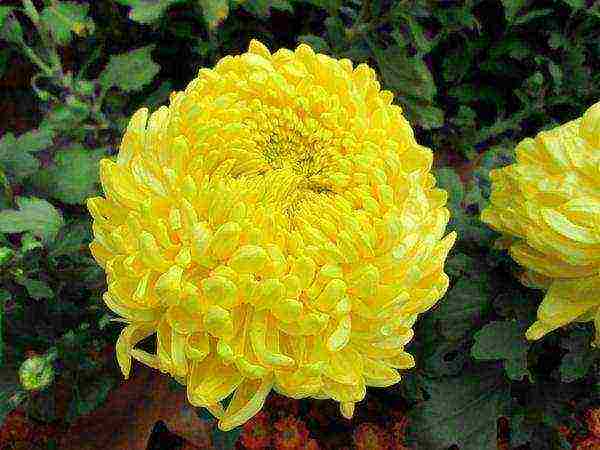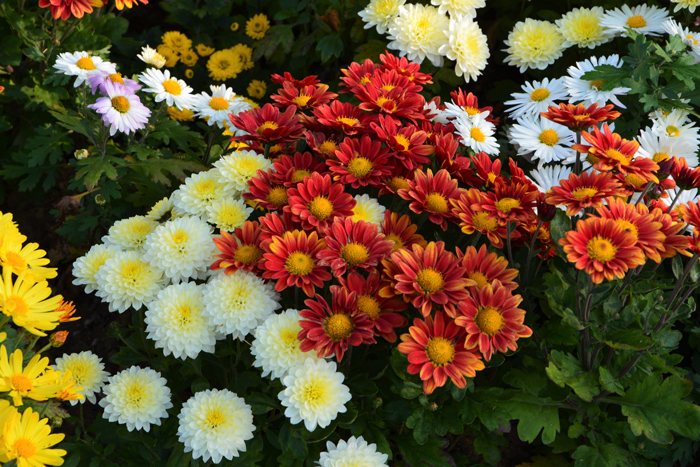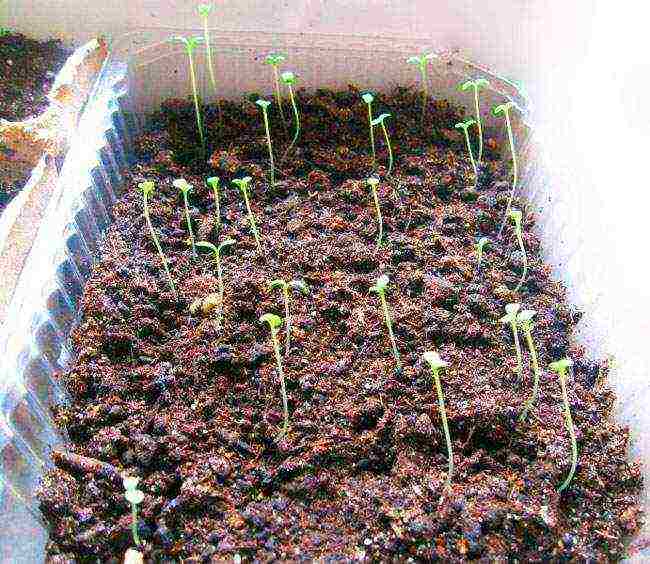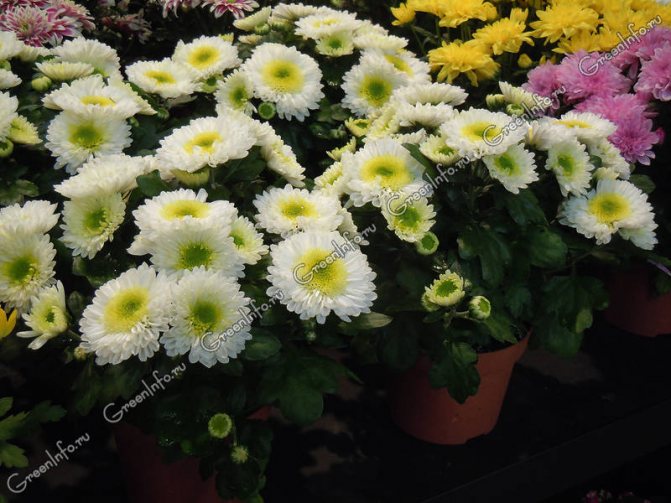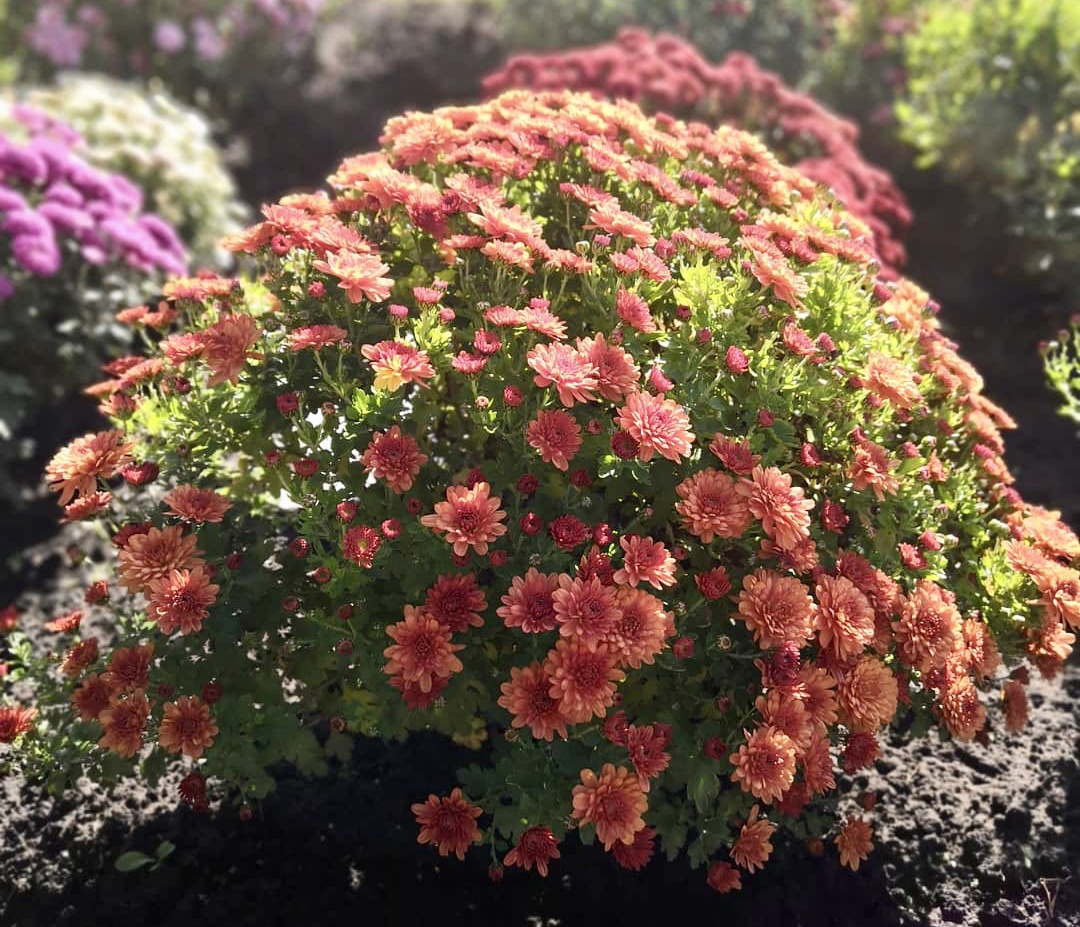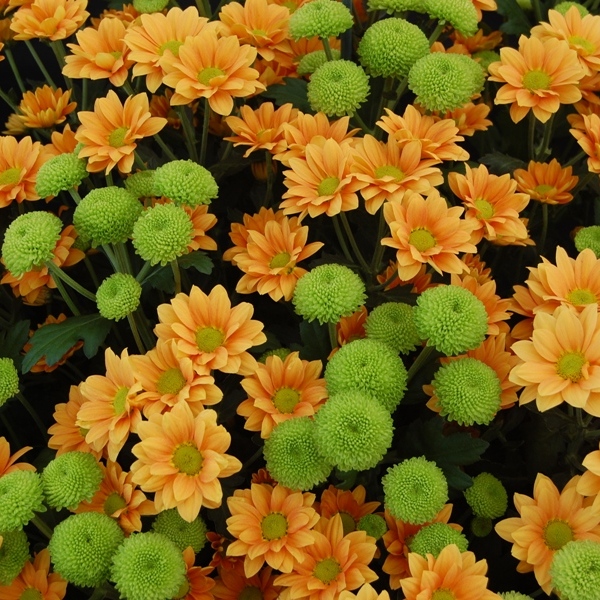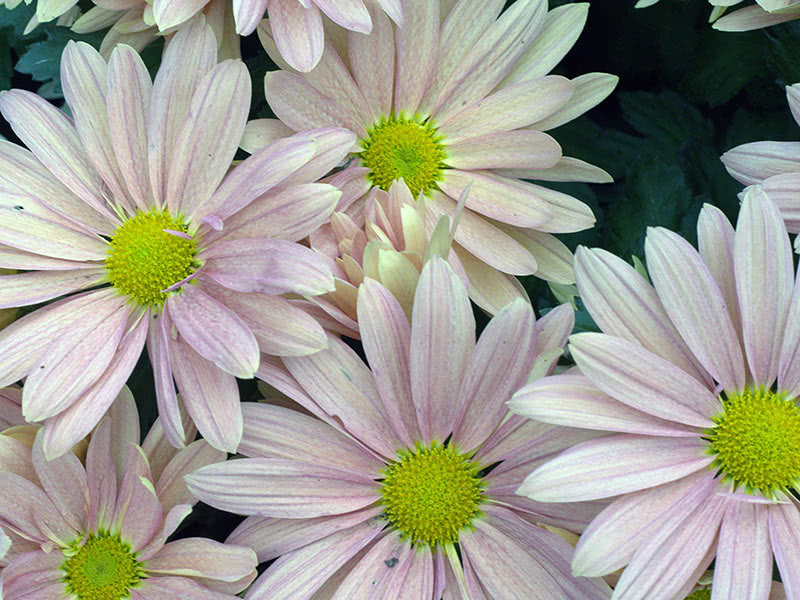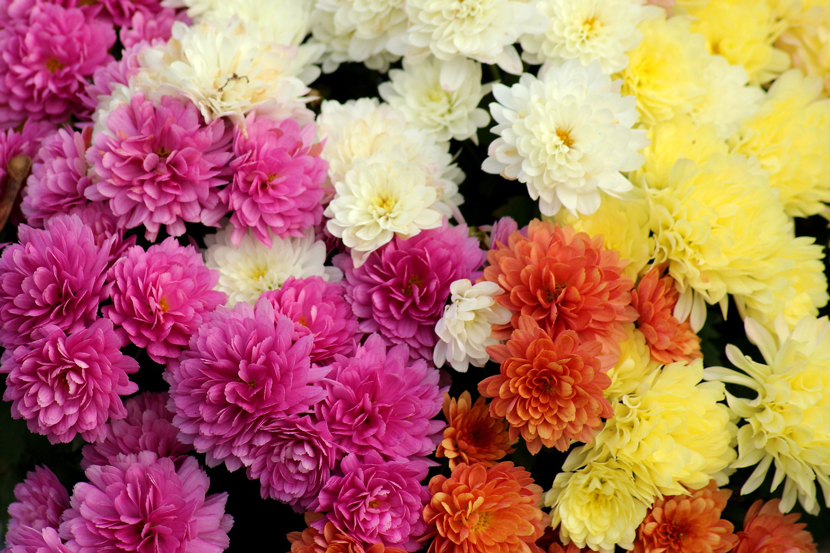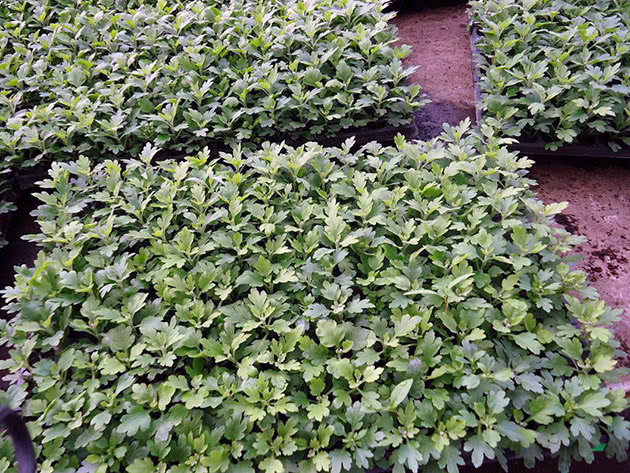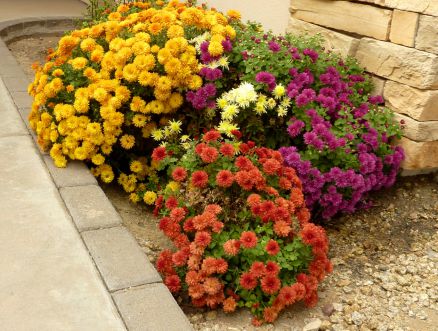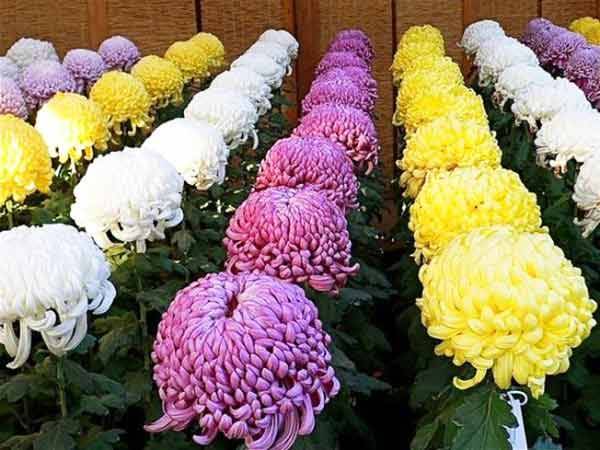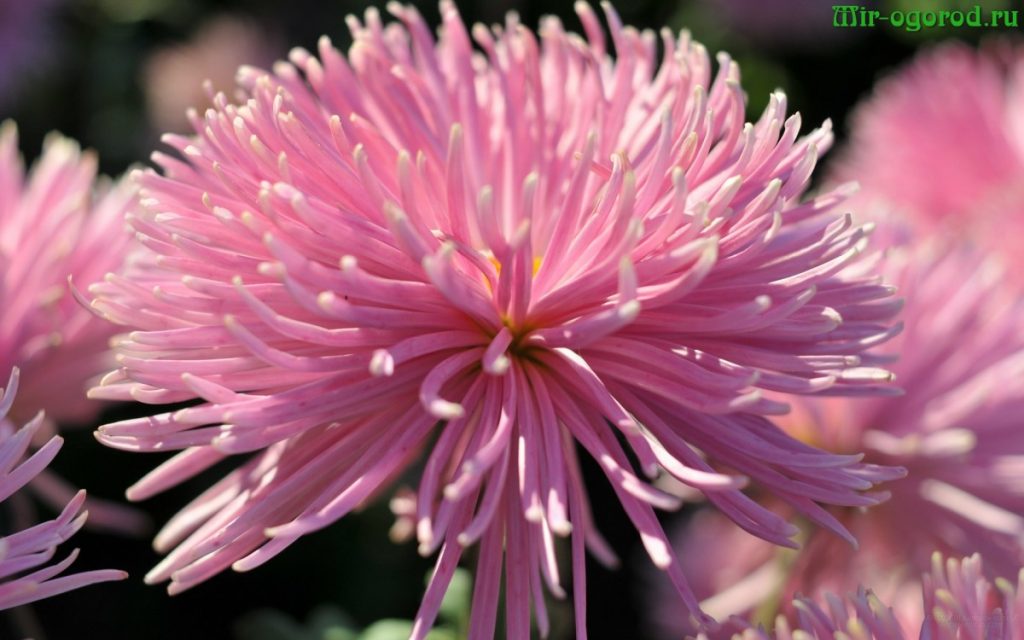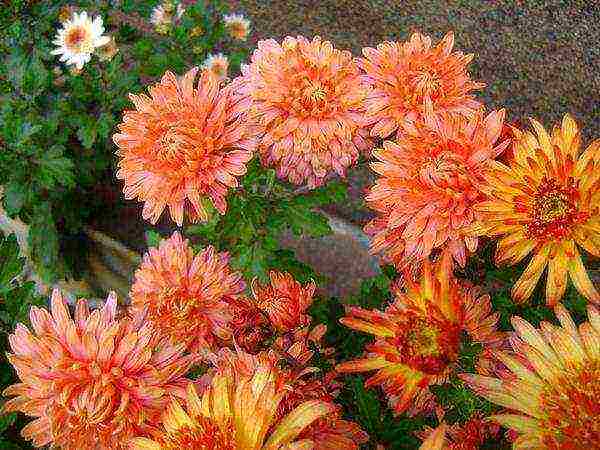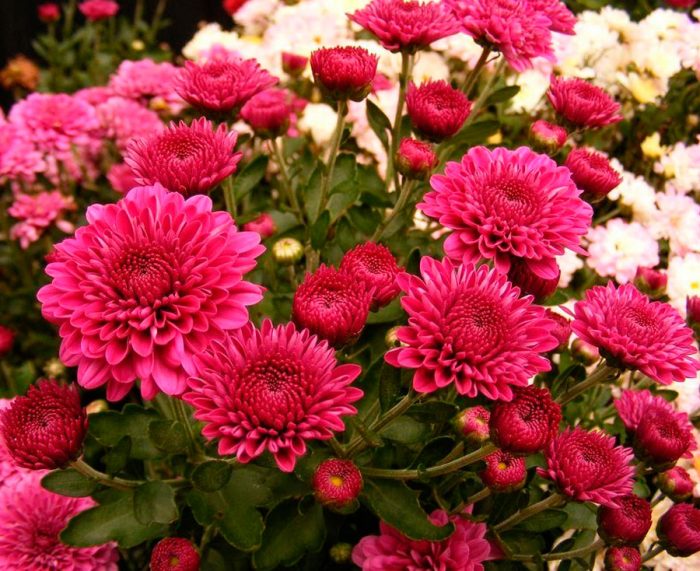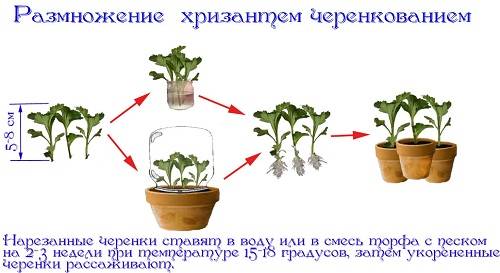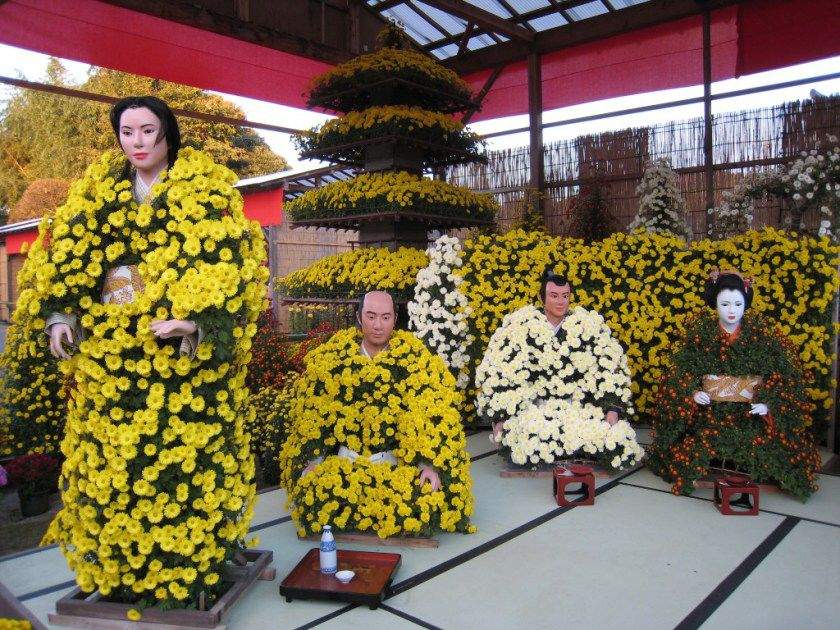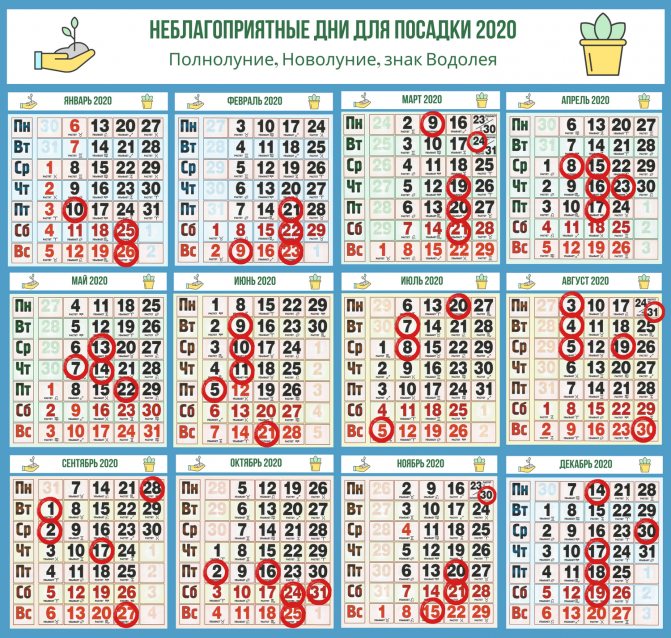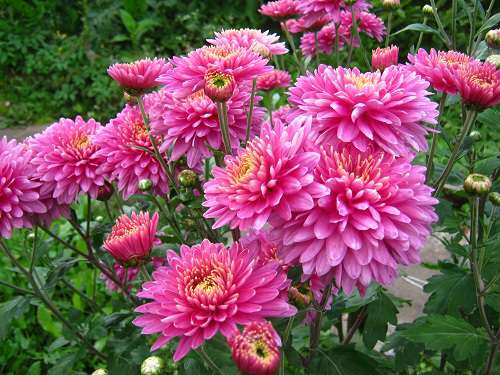Chrysanthemum keeled: characteristic features, varieties, photos
The homeland of the keeled chrysanthemum (chrysanthemum carinatum Shousn) is the North of the African continent. This highly branched erect flower grows to a height of 70 cm. Its green mass is fleshy, grayish-green in color, the protruding parts of the leaves are linear. Baskets of inflorescences are single, collected on lateral branches in groups of 2-3 pieces. The diameter of the flowers is 5-7 cm. The second name of the keeled variety is tricolor, since the corollas of its reed petals are usually painted in 3 colors: white, yellow, pink or reddish brown. Fruits are achenes with caps. The flowering period is from the last decade of June to the end of September.
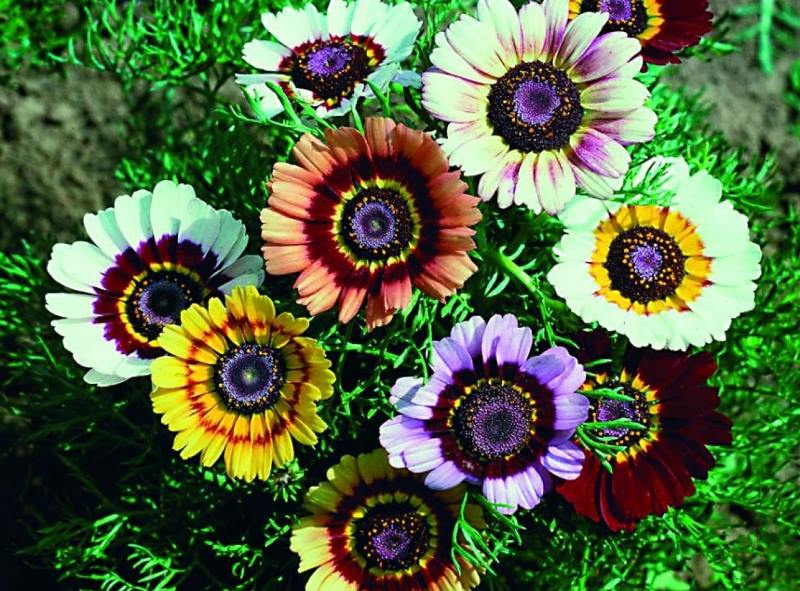 Chrysanthemum keeled Rainbow
Chrysanthemum keeled Rainbow
Today the following varieties are most popular:
- chrysanthemum Masquerade - simple or double flowers of cream, white, yellow, pinkish, red color with a brown bottom;
- Cockade - simple snow-white baskets with egg, red and brown rings, 5-6 cm in diameter;
- Terry chrysanthemum Dunetti - ligulate petals of pale pink, white, yellow or carmine color, tubular lozenges of the core - dark red;
- Atrococenium - inflorescences are simple baskets, rich dark red color;
- chrysanthemum East Star - white-yellow petals and a dark brown core;
- Nordstern is a simple white inflorescence with a carmine ring near a dark core;
- chrysanthemum keeled Grace - yellow reed petals, with a wide red rim closer to the base and a dark brown core;
- Chrysanthemum keeled Rainbow - this is the name of a mixture of 2-3-colored flowers with a different combination in the petals of yellow, white, red, orange, burgundy and brown core;
- chrysanthemum Rainbow - a terry mixture of colors, similar to multi-colored umbrellas with a ringlet, red, white, yellow or pink;
- garden chrysanthemum Tricolor - tricolor flowers similar to chamomile.
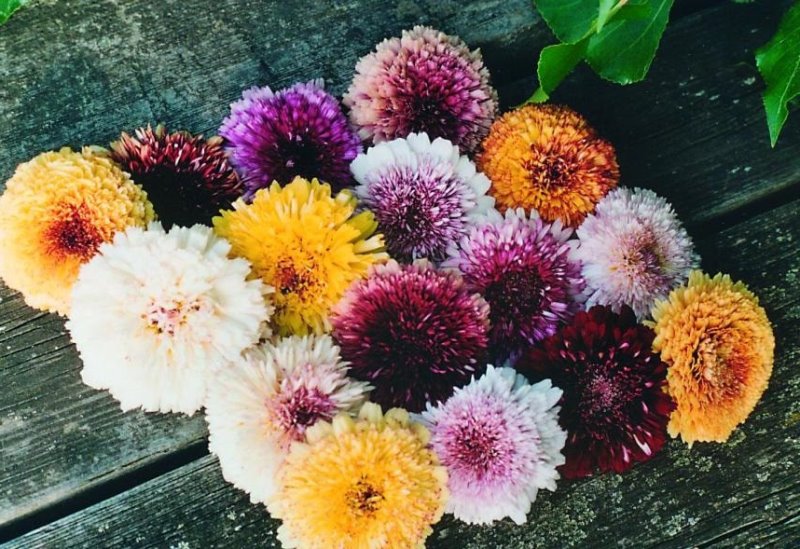 Chrysanthemum Dunetti
Chrysanthemum Dunetti
Due to its unusual color, keeled chrysanthemum is very often used to decorate flower beds and mixborders. Favorites are the lush Dunetti chrysanthemum with ball-shaped double baskets and the Rainbow chrysanthemum with a variety of colors. It is also grown for cutting, retains freshness in bouquets for 4-5 days.
Growing chrysanthemums from seeds
Chrysanthemum seeds
Chrysanthemums propagate most easily by cuttings and division of mother plants, but often chrysanthemums grown from seeds are a subject of special pride for breeders. Seed propagation is used in the cultivation of both perennial (for example, Korean chrysanthemums) and annual species. We will tell you how to grow chrysanthemums using the example of seed reproduction of annual species.
How to grow asters from seeds - a detailed guide
In May, after spring frosts, 2-3 seeds are placed in the holes located 20-25 cm from each other and spilled with warm water and, sprinkling them with earth, cover the garden bed with a vegetable film to keep the soil warm and moisture
As soon as the seedlings hatch, the film must be removed, the soil must be carefully loosened, destroying the weeds. After ten days, the seedlings need to be fed with a strongly diluted Ideal or Rainbow
When the sprouts reach a height of 7-10 cm, leave one strong seedling with 3-4 true leaves in the hole, the rest of the sprouts can be transplanted to another place. Your annuals will bloom in early August. If you want chrysanthemums to bloom early, you need to grow seedlings from seeds first.
Chrysanthemum seedlings
It is necessary to grow seedlings at room temperature in shallow boxes with a soil mixture consisting in equal parts of greenhouse soil, humus and peat. It is better to buy the mixture in a store where it is sold after disinfection and disinfestation, but if you decide to make it yourself, then do not forget to sift and calcine it at a temperature of 110-130 ºC. Pour broken brick or expanded clay at the bottom of the box to create a drainage layer, then place the soil mixture and spread the seeds on it. The seeds of annual chrysanthemums are sprinkled with a layer of earth of 0.5 cm, the seeds of perennials are not covered, but only slightly pressed against the soil.
Now spray the surface with water from a spray bottle, cover the boxes with foil or glass and keep at a temperature of 23-25 ºC, occasionally ventilating and spraying with warm water so that the soil does not dry out.
If the unexpected does not happen, then the seedlings should appear in one and a half to two weeks. Now transfer the containers to the brightest place and begin to gradually accustom the seedlings to the environment, removing the glass or film, first for one hour, then for two, and so on, until it is time to remove the cover completely. If the seedlings are too dense, then when 2-4 leaves appear (not cotyledons, but real ones), they are dived into cups with the same soil mixture, trying not to damage the roots of the chrysanthemum seedlings. To do this, before the dive, the soil in the boxes is abundantly moistened. Weakened or too elongated seedlings are discarded. After picking, the seedlings are sprayed with a solution of Zircon or Epin to help them take root faster.
In the photo: Chrysanthemum seedlings
Chrysanthemum seedlings
Dived chrysanthemum seedlings are kept in a room with a temperature of 16-18 ºC, watered when necessary, and fed twice a month with a solution of complex fertilizer. If necessary, then organize additional luminescent supplementary lighting. Be prepared for the seedlings to grow slowly: in a month and a half they will be about 20 cm in height.
Care for a chrysanthemum in the garden
How to care for chrysanthemums
It is easy to care for a chrysanthemum. If you did not pinch the seedlings immediately after planting, do it at the stage of their eighth true leaf formation. This is necessary in order for the bush chrysanthemum to become thicker. Only large-flowered chrysanthemums do not need to be pinched, from which, on the contrary, all lateral shoots are removed, leaving only a few of the most developed ones. Cut off shoots can be rooted.
Tall chrysanthemums sometimes require a garter to a support. For this purpose, you can dig in a metal rod, a tall wooden peg next to the bush, or put a cylinder of metal mesh around the bush, which will not allow the plant to fall apart.
Chrysanthemum watering
Chrysanthemums are watered abundantly: from a lack of moisture, their stems quickly turn wood, and the flowers lose their attractiveness. Moistening is carried out as soon as the topsoil dries out. For irrigation, they take cold, settled or rain water, to which a few drops of ammonia are added. Pour water so that drops of water do not fall on leaves and flowers. As soon as the water is absorbed, the soil can be loosened and weeded. Although, if you have mulched the surface of the site, you will rarely have to loosen and weed.
Chrysanthemum feeding
During the growing season, chrysanthemum must be fed at least three times alternately with mineral and organic fertilizers. At the beginning of growth, in the first 6-8 weeks after planting, the flower will need ammonia nitrogen, which will help to grow foliage, and during the budding period, the plant is fed for intensive flowering with potassium-phosphorus fertilizers. Chrysanthemum is best perceived by liquid dressings, which are applied under each bush the next day after rain or watering. With the introduction of organic fertilizers (a solution of mullein or bird droppings), moderation should be observed, since an overdose can cause a burn to the plant.
Reproduction of chrysanthemums
You already know how to grow chrysanthemums from seeds. In addition to seed propagation, vegetative methods are also used for growing chrysanthemums - cuttings and dividing the bush.
All chrysanthemums can be propagated by cuttings while preserving not only the species, but also the varietal properties of the parents. Cuttings are harvested from young ground shoots in February or March. Each cutting should have 3-4 knots. Compost soil or peat is poured into the box, and on top of it is a layer of calcined river sand. Chrysanthemum cuttings are placed at an angle with the lower cut in the sand (the cutting should not touch the compost layer), after which the sand is sprayed with water and a transparent cap is put on the box. Rooting takes place at a temperature of 12-15 ºC. When the roots grow from the cuttings, they are seated in separate pots. Cuttings are planted in the garden only when the frost has passed.
At the same time, when the really warm weather sets in, you can propagate chrysanthemum and dividing the bush. Professionals say that performing this procedure every three years has a positive effect on the quality of chrysanthemum flowering.
The bush is carefully dug up, divided into several parts, if necessary, cutting the roots with a sharp, sterile knife. The sections are treated with crushed coal, after which the cuttings are planted in the ground and watered
Chrysanthemums in autumn
In September, apply the last dressing for the chrysanthemums, consisting of potash and phosphorus fertilizers: they will help the plants wintering in the garden to endure frosts. With the beginning of a cold snap, cut the garden chrysanthemum at a height of 10-15 cm, spud the rest of the bush and cover with a thick layer of dry leaves. If the winter is without snow, spruce branches or brushwood should be laid on top of the leaves, but it is impossible to cover the chrysanthemums with an impenetrable film, since they can dry out under it.
Sometimes readers ask the question of how to preserve chrysanthemums that cannot winter in the garden. It's a pity when a beautiful plant dies every fall. You can save the bushes of thermophilic varieties from death by digging them with a large clod of earth and putting them in boxes. They should be kept in a bright place at a temperature of 2-6 ºC and an air humidity of at least 80%. If you only need to keep 2-3 bushes, plant each in a large pot and keep the soil slightly moist throughout the winter.
How to get chrysanthemum seeds
 Chrysanthemum seeds
Chrysanthemum seeds
The seeds of various varieties of chrysanthemums are always on sale, but having grown this flower once, you can collect them yourself. When growing indoor or garden chrysanthemums for seeds, you need to consider the following points:
- Large-flowered and terry varieties give very little seed, and it is difficult to grow them from seeds.
- Small-flowered simple and semi-double chrysanthemums give a sufficient number of seeds with good germination.
- It is easiest to collect high-quality seeds from early and mid-early varieties; in late-flowering varieties, they simply do not have time to ripen.
To have time to get high-quality seeds from a plant with good germination, you need:
- plant seedlings in open ground as early as possible;
- water, feed and pinch regularly;
- make sure that there are no more than 5-8 stems on a small-flowered chrysanthemum, and no more than 3 stems on a large-flowered chrysanthemum;
- leave only one bud on one stem.
With chrysanthemums blooming in mid-summer, the seeds are harvested while they are still in the garden. With plants blooming until late autumn, proceed as follows:
- to protect the flowers from getting wet, if there is no way to transfer them to the greenhouse, the bushes are covered with a film;
- before frost, the plants are transplanted into pots, transferred to the house and placed on a windowsill located on the sunny side;
- if the chrysanthemum has to be grown in a greenhouse, it is covered with a film so that the condensate does not damage the receptacle.
Seeds are harvested in November-December, as soon as the inflorescences turn brown. If this moment is missed, they will crumble.
FAQ
Q: Is it better to use when planting: a peat tablet or plain soil?
A: The probability of sprouting will be the same in any case, although the tablets have their advantages - if you need to change the container to a larger one, it will be more convenient to transplant seedlings from a peat tablet by simply placing them in the container. And without a pill, the likelihood of various injuries to the rhizome is high.
Q: When to plant seedlings in the garden?
A: Optimal when the temperature at night is about 15 degrees.
Q: Do you need a pinch?
A: Yes, for more bushiness. Otherwise, this process will take longer.
Q: Window sill or greenhouse? What is the best way for chrysanthemum germination?
A: Seeds require a minimum temperature of 18 degrees. It is not difficult to achieve these conditions on the windowsill, while in greenhouse conditions the temperature can drop at night. So for the first time it is better to keep the sprouts on the windowsill, and after the appearance of five true leaves, they can be transferred to the greenhouse.
How to transplant a chrysanthemum
Chrysanthemum is considered a frost-resistant plant and can stay in one place for a long time. But from time to time, it needs a transplant, since the soil in which it grows loses useful micro and macro elements. The transplant is carried out in the fall, so that she has time to adapt to a new place. Young globular bushes need to be moved to a new location once a year. Perennials, whose age is 3 years or more, are transplanted once every six months.
Important! It is recommended to replant the plant in cloudy weather. Before digging, the soil must be well moistened.
In this way, damage to the root system is minimized.

Chrysanthemum transplant is done after watering
Landing pits are prepared in advance. Their depth should be about 20 cm, if necessary, drainage is introduced. The distance between the holes must be at least 40 cm.
Next, the bush is dug up, transferred to a new planting hole, covered with earth and watered abundantly. Complex fertilizers can be applied 3 days after transplanting.
When to sow chrysanthemum seeds for seedlings
So you've decided to plant a flower crop for seedlings, but don't know when to plant the seeds? The optimal time for sowing chrysanthemum is mid and late February, early March
It is important to carry out the procedure at the right time, otherwise you may not see flowering in the first year.
In different regions of our country, the time of the procedure may vary, for example, in the southern regions it is possible to plant already in mid-February, in Siberia, in the Urals, in the Leningrad region - at the beginning of March, in the Central region (including the Moscow region) and in Volga region - at the end of February.
You can choose the most suitable sowing dates using the 2020 Lunar Calendar:
Preparation of planting material and soil
When the planting material is selected, the seeds must be prepared for planting. Selected seeds must be disinfected in a weak solution of potassium permanganate and germinated a little in an apartment.
Also at this stage, you should prepare the soil into which the seeds will be sown. You can use either a special potting soil mixture, which is sold in any flower shop, or you can prepare the soil yourself. For these purposes, you can use garden soil cleared of weeds and insects.
For the purpose of disinfection, it is recommended to either steam the soil or treat it with a weak solution of potassium permanganate. The most effective methods of soil disinfection are considered to be freezing and drying in the oven.
Chrysanthemum care
Caring for chrysanthemums consists in regular watering, feeding, removing faded inflorescences, pruning off excess branches and plucking buds. It is necessary in a timely manner - once every three years to rejuvenate the old bushes.
How to water chrysanthemums
At the beginning of the growing season, chrysanthemums are watered about once a week, abundantly wetting the upper layers of the soil. In summer, as the temperature rises, the frequency of watering increases, it can be once or twice a week, depending on the weather.By the time of flowering in September, watering is even more frequent - at least three times a week, but do not forget that frequent watering is permissible only on well-drained soil!
Top dressing
Chrysanthemums require a rich set of nutrients, in addition to nitrogen, phosphorus, potassium, sulfur, calcium and magnesium are needed in significant quantities, and small amounts of iron and manganese are also needed, less significant, but it is desirable that they be part of fertilizers for chrysanthemums: boron, copper and zinc.
Nitrogen - This element contributes to the rapid growth of leaves, but is most useful only at the beginning of the growing season, before the formation of inflorescences. Do not use nitrogen fertilizers later than June! If this element is introduced in excess, especially with a lack of light, the plant forms weak stems and a sluggish root system, it is very easy to get sick with powdery mildew and other diseases.
Phosphorus is vital for the health of chrysanthemums, especially for stimulating root growth and maturation of stems, frost resistance of plants and general immunity depend on the sufficiency of phosphorus. If you apply phosphate fertilizers, do not use double superphosphate, only ordinary, it is easier and more evenly distributed in the soil, contains from 18% to 20% of available phosphoric acid.
Potassium promotes the formation of large inflorescences and dense wood of the stems. But if potassium is added in excess, for example, with ash, the chrysanthemum foliage becomes very fragile, the stems are fibrous, do not hold moisture well and stand worse in the cut.
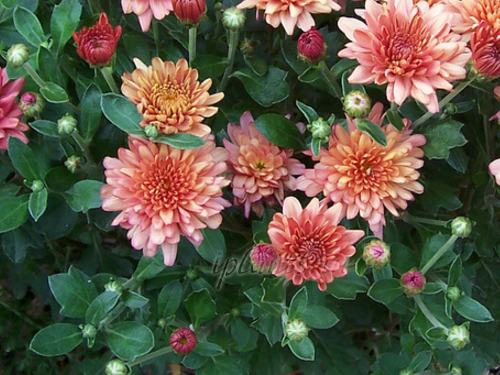
It is best to feed chrysanthemums with a full complex fertilizer, for example, with the NPK 5-10-10 formula, even better with the NPK 5-10-5 formula:
- If chrysanthemums are planted in the current spring, two additional dressings per season are enough.
- If the chrysanthemums were planted a year or two ago, feed them throughout the summer and in the fall once a month.
Since August, only with phosphorus fertilizer.
Growing chrysanthemums from seeds at home
A garden flower such as chrysanthemum is appreciated by many growers. Some types of chrysanthemums are successfully grown outdoors, while others only grow in greenhouse conditions. But all, without exception, bloom for a long time and multiply easily. The Chinese were the first to grow garden chrysanthemum species from 551 BC. NS. Later, the Japanese liked these flowers, and soon the chrysanthemum became the national flower of the country. There is even the highest state award - the Order of the Chrysanthemum, and ancient Japanese poets dedicated poems to these plants. The flower came to European countries in the 17th century, and in Russia they learned about the chrysanthemum only in the 19th century.
Chrysanthemum: growing from seed, when to plant
Chrysanthemums are perennial and annual herbaceous plants of the Compositae family. There are 29 known species of these plants grown in the northern and temperate latitudes of the world. All shades and combinations of white, yellow and red are present in the color of the buds. By height, chrysanthemums are divided into:
- Low-growing or curb (spherical bush 20-30 cm; early flowering);
- Medium height (35-50 cm);
- Tall (60-100 cm; large inflorescences; late flowering).
Since chrysanthemum is unpretentious and easy to care for, any novice florist can grow this flower. The main thing is to adhere to several rules in growing. Sowing seeds in open ground can be done in April - May, depending on the region. But, in order to get an earlier flowering, it is better to use the seedling method. The soil mixture should be light and nutritious. You can buy ready-made soil for flowering plants or prepare yourself. For this, they are taken in equal proportions: greenhouse land, humus and high moor peat. The soil is spilled with boiling water or manganese solution. A layer of expanded clay is poured onto the bottom of the container. There is a small nuance in planting seeds in the soil. The seeds of annual chrysanthemums are sealed to a depth of 0.5-1 cm, and perennial ones need to be spread out on the surface and only slightly pressed into the ground.Moisten from a spray bottle, cover with foil or glass and put in a warm, bright place. The sprouts should appear in 10 to 14 days. After the appearance of 2-4 true leaves, the sprouts dive into separate pots. In this case, it is better to spray the seedlings with special stimulating drugs. This will help the young plants to take root.
Sowing seeds in open ground can be done in April - May, depending on the region. But, in order to get an earlier flowering, it is better to use the seedling method. The soil mixture should be light and nutritious. You can buy ready-made soil for flowering plants or prepare yourself. For this, they are taken in equal proportions: greenhouse land, humus and high moor peat. The soil is spilled with boiling water or manganese solution. A layer of expanded clay is poured onto the bottom of the container. There is a small nuance in planting seeds in the soil. The seeds of annual chrysanthemums are sealed to a depth of 0.5-1 cm, and perennial ones need to be spread out on the surface and only slightly pressed into the ground.Moisten from a spray bottle, cover with foil or glass and put in a warm, bright place. The sprouts should appear in 10 to 14 days. After the appearance of 2-4 true leaves, the sprouts dive into separate pots. In this case, it is better to spray the seedlings with special stimulating drugs. This will help the young plants to take root. Further care of the seedlings consists in regular watering, feeding and maintaining the temperature. Chrysanthemums do not like excessive drying out and strong waterlogging of the soil. Therefore, it should be watered as the earthen coma dries. Chrysanthemums love spraying. Temperature range from +16 to +20 degrees. In open ground, seedlings are planted after the establishment of warm weather and when the threat of night frosts has passed. It is advisable to land on cloudy days. The place is chosen light with fertile soil. Immediately after planting chrysanthemums, it is recommended to pinch the tops of them. This will help to form lush and compact shrubs with abundant flowering. This procedure is repeated as the lateral shoots grow 15-20 cm. For better flowering, you can use phosphorus - potassium fertilizers.
Further care of the seedlings consists in regular watering, feeding and maintaining the temperature. Chrysanthemums do not like excessive drying out and strong waterlogging of the soil. Therefore, it should be watered as the earthen coma dries. Chrysanthemums love spraying. Temperature range from +16 to +20 degrees. In open ground, seedlings are planted after the establishment of warm weather and when the threat of night frosts has passed. It is advisable to land on cloudy days. The place is chosen light with fertile soil. Immediately after planting chrysanthemums, it is recommended to pinch the tops of them. This will help to form lush and compact shrubs with abundant flowering. This procedure is repeated as the lateral shoots grow 15-20 cm. For better flowering, you can use phosphorus - potassium fertilizers. Chrysanthemums look great in group and single plantings, mixborders and rabatkas. Cut flowers can last a long time in bouquets. Chrysanthemums are also grown as pot crops at home.
Chrysanthemums look great in group and single plantings, mixborders and rabatkas. Cut flowers can last a long time in bouquets. Chrysanthemums are also grown as pot crops at home.


